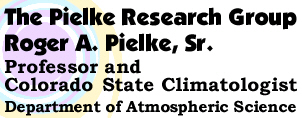IPCC Claim: “Over several decades of development, models have consistently provided a robust and unambiguous picture of significant climate warming in response to increasing greenhouse gases.” (page 600)
and
“…models are unanimous in their prediction prediction of substantial climate warming under greenhouse gas increases, and this warming is of a magnitude consistent with independent estimates derived from other sources, such as from observed climate changes and past climate reconstructions.”(page 601)
Reality: Global warming has not occurred for the last several years
For example, lower tropospheric warming has not occurred since about 2003 (from http://www.remss.com/msu/msu_data_description.html)

Figure caption: Variations of lower tropospheric temperature as diagnosed by RSS MSU measurements [from Figure 7 in http://www.remss.com/msu/msu_data_description.html].
See also, Out On A Limb - The 2007 Bali Climate Declaration By Scientists
In coming weeks, further evidence on the lack of recent upper ocean heating will be presented on Climate Science.
IPCC Claim: “New observational and modelling evidence strongly supports a combined water vapour-lapse rate feedback of a strength comparable to that found in General Circulation Models (approximately 1 W m–2 °C–1, corresponding to around a 50% amplification of global mean warming).” (page 591) and
“Water vapour feedback is the most important feedback enhancing climate sensitivity.” (page 593)
Reality: The increase of water vapor content of the atmosphere has been muted at most zero over the last few years; see
Evidence For A Lack Of Water Vapor Feedback On The Regional Scale

Figure caption: (a) The North American Regional Reanalyis domain-averaged de-seasoned precipitable water vapor - PWAV (blue), total precipitable water content -PWAT (brown), and lower-tropospheric temperature (red), monthly anomaly time series; (b) The North American domain-averaged PWAV, PWAT, and Tcol yearly time series by season. The dashed lines represent a linear fit, and the magnitude of the trends are also shown. The black dashed lines indicate PWAV trends for a fixed relative humidity scenario. Note the much lower (and statistically insignificant trend in PWAV and PWAT despite a significant trend in Tcol [ from Wang, J.-W., K. Wang, R.A. Pielke, J.C. Lin, and T. Matsui, 2007: Does an atmospheric warming trend lead to a moistening trend over North America? Geophys. Res. Letts., submitted].
IPCC Claim: The understanding of anthropogenic warming and cooling influences on climate has improved since the TAR, leading to very high confidence that the global average net effect of human activities since 1750 has been one of warming, with a radiative forcing of +1.6 [+0.6 to +2.4] W m–2 (see Figure SPM.2). (page 3)
and
“Warming of the climate system is unequivocal, as is now evident from observations of increases in global average air and ocean temperatures, widespread melting of snow and ice, and rising global average sea level (see Figure SPM.3).” (page 5)
Reality: Using the IPCC estimate of global radiative forcing and the diagnosis of the radiative imbalance from ocean heat content changes, the global radiative feedbacks are negative.
This is clear from the relationship between current radiative forcing (RF), current radiative imbalance (RI), and current radiative feedback (RFB), where
RI = RF + RFB.
If RI is less than RF, the radiative feedback, RFB, is negative. Jim Hansen, as reported on Climate Science (see) estimates RI in the 1990s as 0.85 Watts per meter squared. This is a high estimate but it still illustrates that the current radiaitve forcing must be less than 0.85 Watts per meter squared for the radiative feedbacks to be positive! If the value of the current Radiative imbalance, RI, is smaller, than the current radiative forcing, RF, must be even smaller in order to have a postivie radiative imbalance. The net conclusion is that either the 2007 IPCC estimates of the net radiative forcing is too positive and/or their estimates of the radiative feedbacks in the models are in error. A combination of both of these effects are likely.
For further discussion see
and
Why We Need Estimates Of The Current Global Average Radiative Forcing
These failures of the projections (predictions) of the 2007 IPCC report, by themselves, should result in the rejection of the IPCC report as representing settled climate science.

